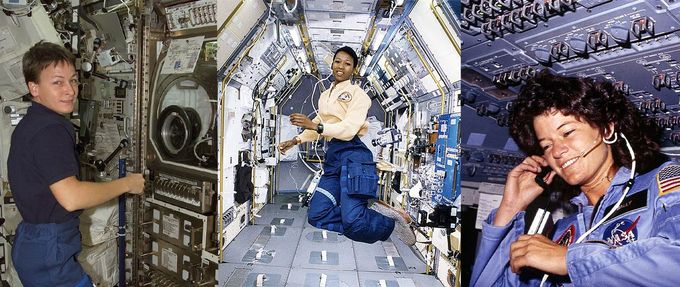Earlier this year, an 11-minute commercial space flight taken by six women on board Blue Origin attracted an extraordinary level of global media coverage. This brief mission was designed to generate publicity and included high-profile celebrities like Katy Perry and Gayle King. Yet, dating back to its earliest days, courageous and pioneering women have made significant contributions in the field of space exploration and continue to break new barriers today. Here are just a few of their extraordinary stories.
Valentina Tereshkova
In June 1963, 26-year-old Soviet cosmonaut Valentina Tereshkova became the first woman to be launched into space on board Vostok 6. There was little to suggest from her early life in the historic Russian region of Yaroslavl that she would one day become a pioneer of space exploration. Her father, Vladimir, was killed on active service during World War II, leaving her mother, Elena, as the sole breadwinner for the couple’s three children. Upon leaving school, Tereshkova joined her mother at work in the mundane surroundings of the local textile mill.
The first outward sign of her penchant for thrill-seeking adventure came when she joined a local skydiving and parachute club. When she subsequently decided to answer a call for female candidates to train as cosmonauts, her ability to jump out of a plane helped her to make the final cut. Upon their return journey, early space crews would customarily eject from their spacecraft by parachute during the final descent at a height of around four miles above the earth.
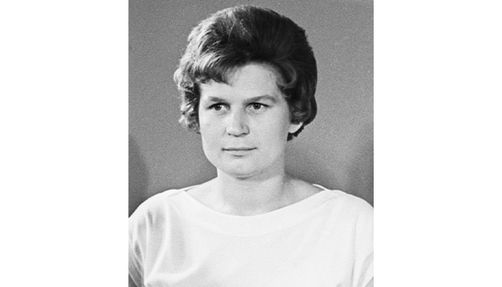
Valentina Tereshkova, 1963
Photo Credit: WikipediaTereshkova was selected to undertake 18 months of intensive physical training with the Soviet Air Force before she was given the go-ahead to pilot Vostok 6. During her three-day solo mission, the capsule circled the earth 48 times, closely tracking the orbit of another Russian spacecraft, Vostok 5, so that the two pilots could test a new two-way radio telecommunications system.
Vostok 5, was piloted by male cosmonaut, Valery Bykovsky, leading to some questionable press coverage. Describing Tereshkova as “attractive, but plumpish…with a dimple in her chin”, many US newspapers carried an identical syndicated report which revealed: “The world’s first woman in space wore powder and lipstick for the expected out-of-this world meeting with the Russian man”.
Tereshkova’s mission provided an invaluable insight into how female physiology reacted to space travel, as well as proving a major propaganda coup for the Russian authorities who reveled in the fact that they had beaten their bitter American rivals to put the first woman in space. Their first female cosmonaut was awarded an impressive range of military medals and subsequently forged a highly successful career as a politician. Now 88 years old, Tereshkova has, however, never fulfilled her ambition of returning to space.
Sally Ride
NASA only finally sent its first female astronaut into space two decades after Tereshkova’s historic flight, when Sally Ride was selected as one of five crew members for the Challenger space shuttle’s second mission in June 1983.
Born in Los Angeles, in May 1951, Ride proved herself to be a gifted all-rounder from an early age. As well as displaying exceptional academic ability, she was also a natural athlete and showed a particular aptitude for tennis, proving so successful on the junior circuit that she even considered pursuing a professional career in the sport. In the end, she concentrated on her studies, focusing on astrophysics for her doctorate.
Reportedly long fascinated by the subject of space exploration, Ride had just completed her PhD when she heard that NASA was launching a recruitment program for female astronauts. She grabbed this opportunity of a lifetime with both hands, beating more than 8,000 applicants to become one of just six women accepted for astronaut training in early 1978. As part of her training, Ride was required to learn a whole new set of skills ranging from scuba diving and piloting a jet aircraft to coping with weightlessness and the extreme G-forces experienced on take-off.
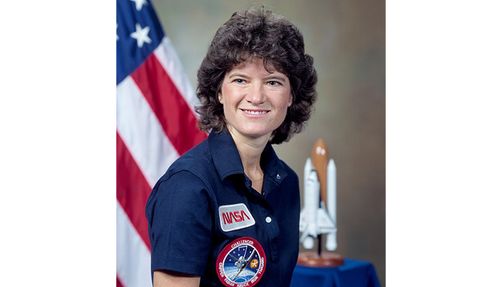
Sally Ride, 1984
Photo Credit: WikipediaHer presence on the Challenger crew attracted huge media attention. Many interview requests were declined, as she focused on preparation for the mission ahead, but she did attend NASA’s official pre-launch press conference a month before the flight. Here she faced a barrage of “distastefully personal” questions (according to NASA spokesman, John Lawrence) such as “Do you weep when things go wrong on the job?” and “How will you handle menstruation in space?”. Ride remained serenely calm and self-assured throughout, revealing exactly the type of level-headed temperament which had led to her selection in the first place.
Ride spent six days on the space shuttle for that 1983 mission, during which she became the first astronaut to operate an innovative new 50-foot robotic arm, designed to assist with the deployment of satellites. The use of this equipment subsequently became standard practice on space shuttle missions.
She returned to space for a second mission the following year, but a planned third trip was shelved following the heartbreaking loss of the Challenger space shuttle in January 1986. Ride was one of those asked to join the official investigation into the circumstances that led to this tragic incident.
Mindful of her unique position as the first American woman in space, Ride became a passionate advocate for female scientists and engineers, encouraging the next generation of girls to pursue careers in technology, until her untimely death, aged just 61, in 2012.
Helen Sharman
Yorkshire-born Helen Sharman was working as a chemist for the confectionary company, Mars, in the late 1980s when she responded to a radio advertisement looking for applicants to join Project Juno. With the Cold War coming to an end, this joint initiative between the UK and the Soviet Union, largely funded by a private consortium, was meant to improve diplomatic relations between the two countries by sending a British astronaut to the Russian Space Station.
Chosen ahead of nearly 13,000 other applicants, Sharman received the news that she had been selected for the mission live on British television. Most of her training took place at the world-renowned cosmonaut training center at Moscow’s Star City, following in the footsteps of Valentina Tereshkova who had been put through her paces there nearly three decades earlier.

Helen Sharman, 2015
Photo Credit: WikipediaEighteen months later, in May 1991, 27-year-old Sharman became the first British person in space when she set off on her eight-day mission to the Mir space station. She was often portrayed in the media as an “ordinary” woman. However, Sharman’s considerable aptitude for science and foreign languages, along with her exceptional ability to work well under pressure as part of a team, made her the perfect candidate for the role.
As a highly qualified chemist, Sharman played an active part in the mission, conducting a variety of important scientific experiments during her time on Mir. Yet, as the first privately funded person to go into space, she also paved the way for the future commercial spaceflight industry, enabling private citizens like those on the recent much-hyped Blue Origin mission to enjoy their own brief moment high in the skies above the earth.
Mae Jemison
When Mae Jemison blasted off with six other astronauts on board the space shuttle, Endeavour, in September 1992, she became the first African American woman in space.
Jemison was born in Alabama in October 1956, but was brought up in Chicago. Fascinated by space exploration since childhood, she successfully applied for NASA’s astronaut program in the late 1980s.
Even before her astronaut training, Jemison had proved herself to be a high achiever, winning a scholarship to Stanford University at the age of just 16 and achieving degrees in both chemical engineering and medicine. She then worked as a Peace Corps doctor in West Africa before applying to become an astronaut. During her time with NASA, Jemison inevitably attracted a lot of media attention and was even one of those featured on a 1989 CBS TV special entitled Best Catches as one of the world’s “most eligible singles”.
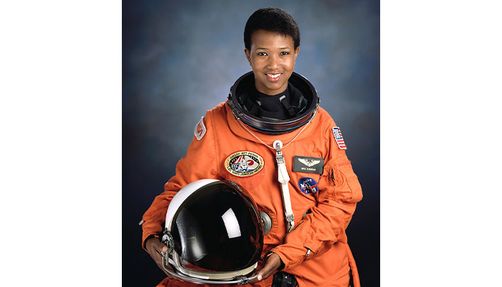
Mae Jemison, 1992
Photo Credit: WikipediaThe pioneering scientist had already proved her mettle by her decision to become a member of the first group of trainee astronauts to be recruited following the Challenger disaster. However, her big moment came when she was selected to fly on Challenger’s replacement, Endeavour. Jemison was chosen as science mission specialist for the new shuttle’s second mission, in September 1992, and conducted a series of wide-ranging experiments on board the Spacelab module, from the effects of weightlessness and motion sickness on the crew to the evolution of tadpoles in space
Jemison left NASA around six months after her return to earth and founded her own science consultancy firm, focusing particularly on the implementation of sustainable technology for developing countries. In recent years, she has also played a leading role in the ambitious 100 Year Starship project, whose objective is to make human travel beyond this solar system a possibility within the next century.
Peggy Whitson
The record-breaking career of Peggy Whitson has proven beyond any doubt that women are able to handle long space missions just as well as their male counterparts.
Born in 1960, Whitson was brought up on a farm in rural Iowa before achieving a doctorate in biochemistry and forging a successful career as a scientist at NASA’s Johnson Space Center from 1986 onwards. From the start, her ambition was to make it into space, but she had to endure a decade of setbacks before finally being accepted for NASA’s astronaut training program in 1996.
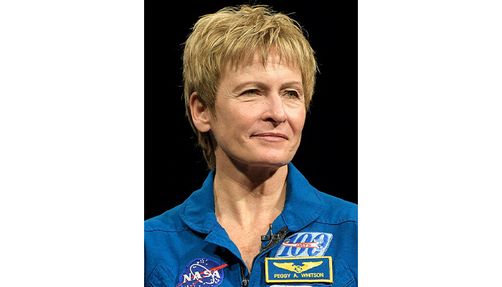
Peggy Whitson, 2018
Photo Credit: WikipediaWhitson served on three long-duration NASA missions to the International Space Station (ISS) from 2002 to 2017, clocking up a record-breaking cumulative total of 675 days in space. Along the way, she became the first woman to serve as ISS commander (twice), contributed to hundreds of science experiments and completed ten spacewalks.
She retired from NASA in 2018 but was far from done with space travel. Whitson took on a new role as a consultant at Axiom Space, a privately funded US space exploration company, and, in May 2023, headed Axiom 2, the second all-private astronaut mission to the International Space Station.
This redoubtable woman has recently returned once more to the ISS as the commander of Axiom 4. Now aged 65, her latest mission launched, with little fanfare, from the Kennedy Space Center on June 25, 2025.
Featured photos: Wikipedia
